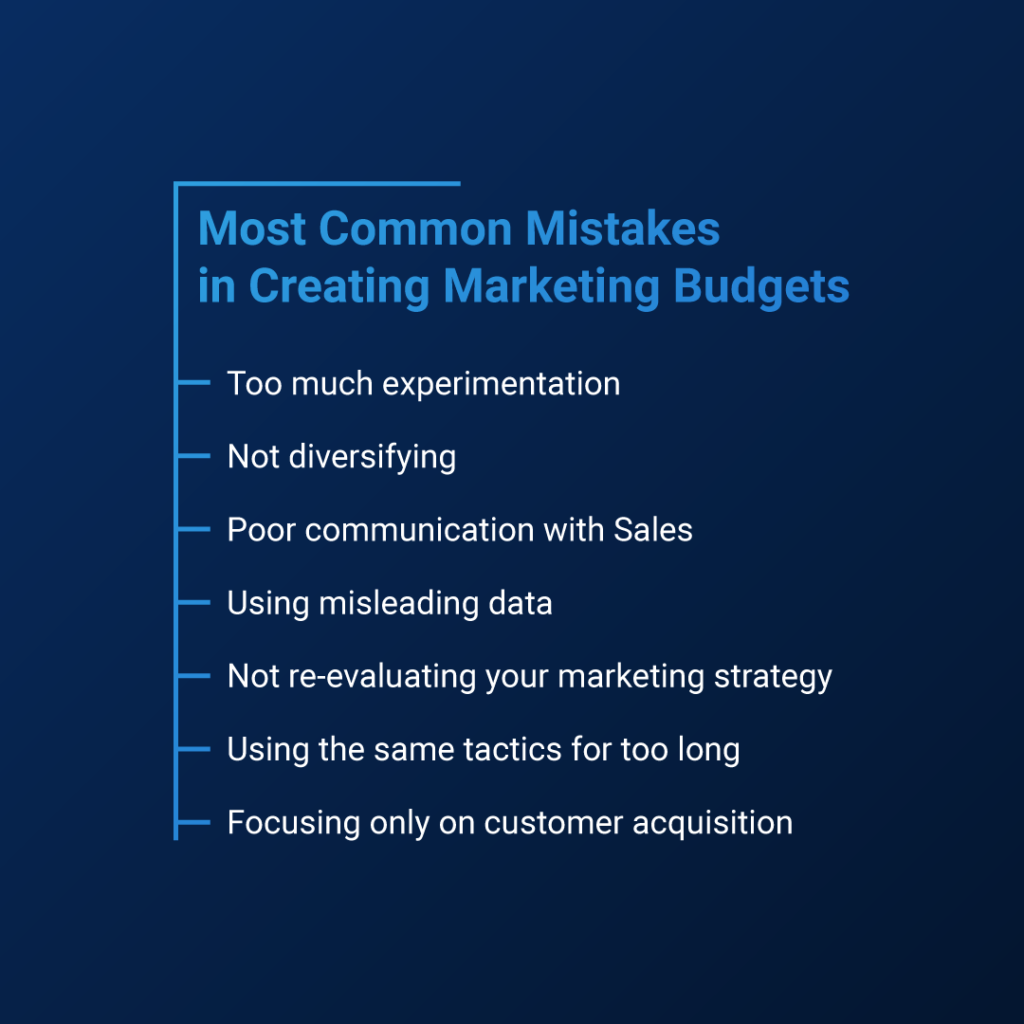You would be surprised by how many mistakes businesses make when building and allocating a marketing budget. Even top-tier marketing teams of industry-leading companies can fall victim to setbacks. Examples of large advertising budgets were mentioned in our last SME article, “Marketing Budget Examples by Industry and Business Size”. When the stakes are that high, the smallest of errors can prove to be immensely costly.
This article focuses on the top mistakes to avoid so you don’t have to learn through trial and error. ‘Half the money I spend on advertising is wasted; the trouble is I don’t know which half.’ This famous quote was uttered over 100 years ago by John Wanamaker, who is one of the marketing forefathers. The notion still applies today and this article will help you figure out which half is potentially wasted in your business.

Common Advertising & Marketing Budget Mistakes Businesses Make
This section showcases some marketing budget mistakes you may be making right now. Pay attention and you may spot some that you are making right now with your business. Once you know what to look for, reversing or avoiding these mistakes is simple.
Mistake 1: Experimenting too much with your budget
Businesses require stability to grow consistently. Therefore, find marketing channels that are proven winners over the long term and always allocate funds towards them. Multichannel marketing is important for diversification and growth – after all, 95% of marketers understand its importance. However, don’t make the mistake of investing too many funds into the channels that have not proven to deliver positive ROI consistently.
Marketing channels that provide a strong ROI should ideally be exhausted for maximum growth. For example, if a specific PPC campaign keyword provides a 50% ROI, then enough funds should be allocated to that keyword to capture each search result.
Mistake 2: Not diversifying
This is in contrast to mistake 1, and the problem is playing it too safe. Without exploring new channels there is no way of knowing what results they could bring. New marketing channels could potentially provide higher ROI than your top currently performing one. 42% of retail executives spend up to half their marketing budget on omni-channel initiatives. What this means is that more than half of businesses are passing up opportunities to expand their marketing portfolio.
What portion of your budget should you spend on new channels? That’s a great question! Around 15-20% is a fair amount. It depends on the size of your budget, your growth strategy, and risk assessment of new channels.
Mistake 3: Not communicating with sales
One of the primary goals of marketing is to bring in sales. However, marketers may not have a good handle of sales numbers without communicating with the relevant department. Marketers need feedback to understand what’s working and areas that require improvement. The best execution of this strategy occurs in real-time. This allows marketers to make adjustments early on in the new campaign cycle to carry out modifications before more money is wasted.
What’s the best way that marketers can communicate with sales?
Nowadays, software and tools exist that bridge the gap with little need for direct communication. Automated systems can relay the necessary information back to marketers from sales events. However, meetings between the two departments every now and then would prove fruitful. The collaborative effort is worth it because 52% of marketers say that they share common goals and metrics.
Mistake 4: Using misleading or bad data
Budget allocation decisions should be made based on solid data in a reliable and repeatable manner. Intuition is a good idea in small doses, but data is a better strategy when the fate of a business is on the line. Many businesses make the correct decisions to rely on data, but the mistake of using the wrong data when making those decisions. CRM (Customer Relationship Management) software can help get reliable data. However, only 33% of marketers trust the information retrieved from such software.
To improve data quality, regular cleaning processes are required. This removes duplicates and inaccuracies that could be swaying data in the wrong direction. When you begin improving the quality of data, then your decision-making in advertising will be better. You’ll have more confidence in those decisions and marketing campaign ROI will improve.
Mistake 5: Not re-evaluating your marketing strategy
Before allocating a budget, the marketing plan must be finalized. However, keep in mind that marketing plans change and adjust to a variety of factors – including (but not limited to) market response, economic changes, and business strategy adjustments. This means that once created, a marketing plan has to be agile – and as such, the marketing budget should allow for some wiggle room too.
As technologies change and new strategies are developed, marketing plans must be updated to incorporate them. Otherwise, the competition will leave you behind and so will your customers. The intervals at which marketing strategy is updated should not be too exhausting. A balance should be struck that promotes re-evaluation at a productive frequency.
Mistake 6: Assuming events or circumstances will return to “normal”
Marketers find a niche or groove where they can’t believe their luck with the high ROI of a marketing channel. They might spend years exploiting the resource, and suddenly something changes that causes the strategy to be unprofitable.
At this point, many marketers assume that eventually things will revert back. This is counter-productive, because instead of searching for new marketing channels to invest the freshly available funds, marketers spend their time waiting for a strategy that may no longer be possible.
To avoid wasting time when circumstances change on a winning strategy, you should immediately invest funds into another strategy. These backup strategies can be researched ahead of time. Therefore, when a worst case scenario occurs, then you can act immediately instead of panicking.
Mistake 7: Only focusing on new customer acquisition
70% of marketers share that it is cheaper to retain existing customers than acquire new ones. Therefore, it’s more cost-productive to allocate a marketing budget towards generating sales from existing customers. However, many businesses believe that business growth lies in new customer acquisition and push most of their resources in that direction.
Doing this isn’t efficient though.
Existing customers are easier to market to because they already trust your brand since they have demonstrated a willingness to buy your products. Also, you have their contact details and a buying history record. This information can be used to send cheap marketing messages that are a fraction of the cost of what you might spend with a PPC campaign.
Arguably, the biggest sales in terms of dollar value are generated from existing customers. That’s because they are more likely to spend money on a big purchase if they have made a smaller one, and are happy with the product quality. Upselling is a business strategy that is very profitable and requires a small number of marketing resources. Smart budget allocation should always include upselling and cross-selling since this can be the backbone of a business.
Click Fraud: A Budgeting Issue to Consider
Click fraud can deplete an advertising budget and leave you scratching your head about why visitors are not biting on your offer. The definition of click fraud is the act of illegally clicking on PPC ads to decrease the advertiser’s budget or increase site revenue. Therefore, it’s possible for large chunks of your PPC budget to be depleted through invalid clicks.
The problems of click fraud go beyond wasting marketing spend. It may lead you to draw incorrect conclusions about the market, which also impacts other channels. For example, if many keywords are converting poorly around a specific demographic, you may conclude that it is not part of your target market. Consequently, you may reduce marketing spend towards this demographic in all your other marketing channels. In reality, invalid clicks may reduce the ROI of those keywords and are profitable when click fraud is removed.
So what can you do about removing click fraud to save your marketing budget and sanity? Invest in ClickGUARD! It will protect your Google Ads from competitors, bot clicks, and bad actors to prevent waste, maximize ROAS, boost profitability, get real users and grow your business. The cost of ClickGUARD is small in comparison to the amount of money you will save with better-performing ads.
Final thoughts
To summarize, there are many mistakes that you could make when allocating your marketing budget allocation. Being aware of these problems can help avoid them for your business to pursue higher profitability and growth. Remember that mistakes are a part of evolving your business towards higher efficiency. Making them is not the issue, but failing to learn from them is problematic.
We encourage you to learn more about business and marketing by looking through other articles in our blog. We cover interesting and thought-provoking topics to help run your business successfully.



